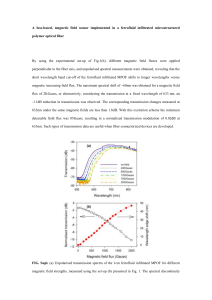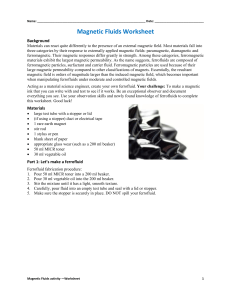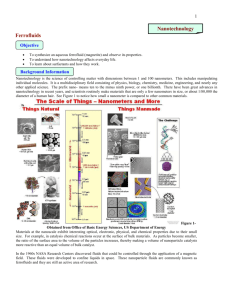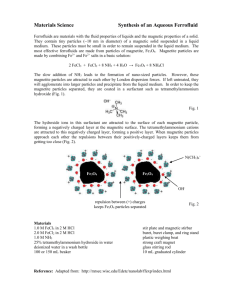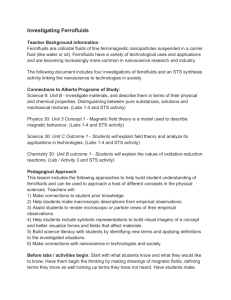Preparation and Properties of an Aqueous Ferrofluid
advertisement
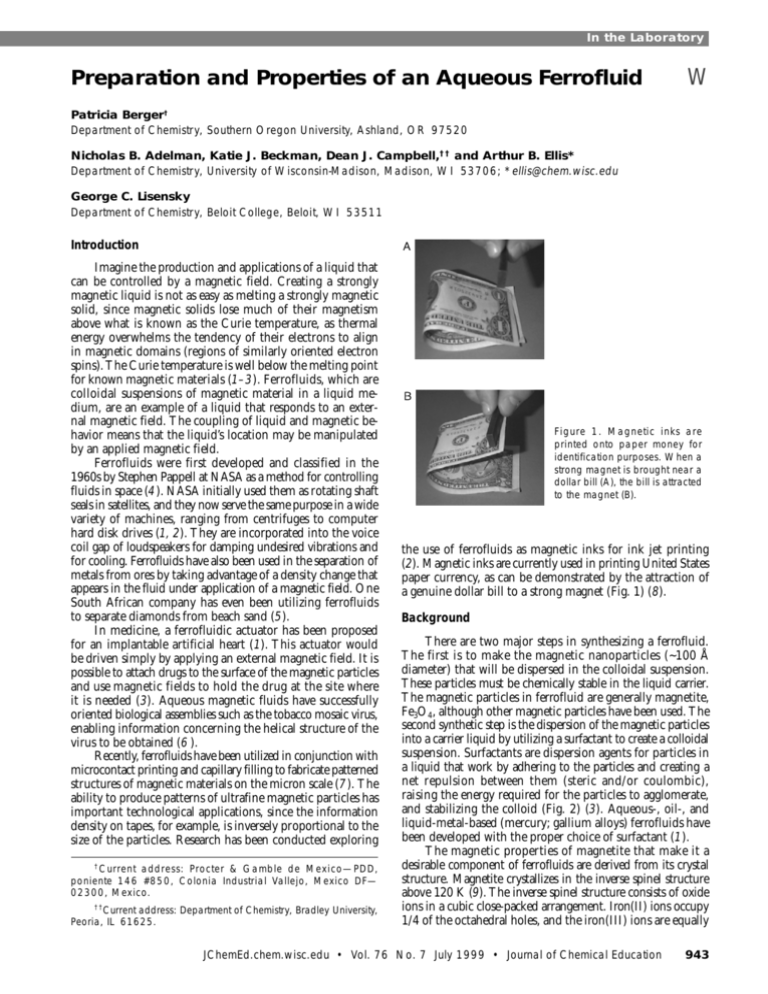
In the Laboratory
Preparation and Properties of an Aqueous Ferrofluid
W
Patricia Berger†
Department of Chemistry, Southern Oregon University, Ashland, OR 97520
Nicholas B. Adelman, Katie J. Beckman, Dean J. Campbell,†† and Arthur B. Ellis*
Department of Chemistry, University of Wisconsin-Madison, Madison, WI 53706; *ellis@chem.wisc.edu
George C. Lisensky
Department of Chemistry, Beloit College, Beloit, WI 53511
Introduction
Imagine the production and applications of a liquid that
can be controlled by a magnetic field. Creating a strongly
magnetic liquid is not as easy as melting a strongly magnetic
solid, since magnetic solids lose much of their magnetism
above what is known as the Curie temperature, as thermal
energy overwhelms the tendency of their electrons to align
in magnetic domains (regions of similarly oriented electron
spins). The Curie temperature is well below the melting point
for known magnetic materials (1–3). Ferrofluids, which are
colloidal suspensions of magnetic material in a liquid medium, are an example of a liquid that responds to an external magnetic field. The coupling of liquid and magnetic behavior means that the liquid’s location may be manipulated
by an applied magnetic field.
Ferrofluids were first developed and classified in the
1960s by Stephen Pappell at NASA as a method for controlling
fluids in space (4). NASA initially used them as rotating shaft
seals in satellites, and they now serve the same purpose in a wide
variety of machines, ranging from centrifuges to computer
hard disk drives (1, 2). They are incorporated into the voice
coil gap of loudspeakers for damping undesired vibrations and
for cooling. Ferrofluids have also been used in the separation of
metals from ores by taking advantage of a density change that
appears in the fluid under application of a magnetic field. One
South African company has even been utilizing ferrofluids
to separate diamonds from beach sand (5).
In medicine, a ferrofluidic actuator has been proposed
for an implantable artificial heart (1). This actuator would
be driven simply by applying an external magnetic field. It is
possible to attach drugs to the surface of the magnetic particles
and use magnetic fields to hold the drug at the site where
it is needed (3). Aqueous magnetic fluids have successfully
oriented biological assemblies such as the tobacco mosaic virus,
enabling information concerning the helical structure of the
virus to be obtained (6 ).
Recently, ferrofluids have been utilized in conjunction with
microcontact printing and capillary filling to fabricate patterned
structures of magnetic materials on the micron scale (7 ). The
ability to produce patterns of ultrafine magnetic particles has
important technological applications, since the information
density on tapes, for example, is inversely proportional to the
size of the particles. Research has been conducted exploring
†
Current address: Procter & Gamble de Mexico—PDD,
poniente 146 #850, Colonia Industrial Vallejo, Mexico DF—
02300, Mexico.
††
Current address: Department of Chemistry, Bradley University,
Peoria, IL 61625.
Figure 1. Magnetic inks are
printed onto paper money for
identification purposes. When a
strong magnet is brought near a
dollar bill (A), the bill is attracted
to the magnet (B).
the use of ferrofluids as magnetic inks for ink jet printing
(2). Magnetic inks are currently used in printing United States
paper currency, as can be demonstrated by the attraction of
a genuine dollar bill to a strong magnet (Fig. 1) (8).
Background
There are two major steps in synthesizing a ferrofluid.
The first is to make the magnetic nanoparticles (~100 Å
diameter) that will be dispersed in the colloidal suspension.
These particles must be chemically stable in the liquid carrier.
The magnetic particles in ferrofluid are generally magnetite,
Fe3O4, although other magnetic particles have been used. The
second synthetic step is the dispersion of the magnetic particles
into a carrier liquid by utilizing a surfactant to create a colloidal
suspension. Surfactants are dispersion agents for particles in
a liquid that work by adhering to the particles and creating a
net repulsion between them (steric and/or coulombic),
raising the energy required for the particles to agglomerate,
and stabilizing the colloid (Fig. 2) (3). Aqueous-, oil-, and
liquid-metal-based (mercury; gallium alloys) ferrofluids have
been developed with the proper choice of surfactant (1).
The magnetic properties of magnetite that make it a
desirable component of ferrofluids are derived from its crystal
structure. Magnetite crystallizes in the inverse spinel structure
above 120 K (9). The inverse spinel structure consists of oxide
ions in a cubic close-packed arrangement. Iron(II) ions occupy
1/4 of the octahedral holes, and the iron(III) ions are equally
JChemEd.chem.wisc.edu • Vol. 76 No. 7 July 1999 • Journal of Chemical Education
943
In the Laboratory
divided between 1/8 of the tetrahedral holes and 1/4 of the
octahedral holes. Electron spins of iron(III) ions in octahedral
holes are aligned antiparallel to those in tetrahedral holes;
therefore, no net magnetization is observed from these ions.
The iron(II) ions, however, tend to align their spins parallel
with those of iron(III) ions in adjacent octahedral sites, leading
to a net magnetization. This arrangement of antiparallel spins
throughout the solid that do not completely cancel is referred
to as ferrimagnetism. Ferrofluids are actually superparamagnetic, meaning that a ferrofluid reacts to a magnetic field in
the same way as a ferromagnetic or ferrimagnetic solid, but
magnetizes and demagnetizes more rapidly because in a ferrofluid the magnetic domains are the same size as the actual
particles. Manganese and cobalt ferrites, MnFe2O4 and CoFe2O4,
respectively, also have the inverse spinel structure and have
been used in the preparation of ferrofluids (10).
The layer sequences for a conventional cubic unit cell and
for a smaller tetragonal unit cell for magnetite are shown in
Figure 3. The Fe24O32 cubic unit cell and the Fe12O16 tetragonal unit cell both have the same empirical formula,
Fe3O4. Construction directions using the ICE Solid-State
Model Kit (11) are included in the Supplemental Material.
A cubic unit cell built with the kit is shown in Figure 4.
For magnetite to remain in suspension, its particle diameters need to be on the order of 10 nm (100 Å) (2, 4b). At
room temperature, the thermal energy of these colloidal
particles is of the same order of magnitude as the gravitational
and magnetic attraction, ~4 × 10{21 J, and therefore the
particles remain suspended. The original ferrofluids developed
at NASA used finely divided magnetite, prepared by grinding
in a ball mill for several weeks to obtain particles of an appropriate colloidal size. Carrier liquid, surfactant and a dispersant
were added during the grinding process to prevent agglomeration of the nanoparticles. In an alternative procedure, as
used in this paper, magnetite is synthesized in solution and
precipitated as nanoparticles (2, 3).
Figure 2. Idealized illustration of
an aqueous ferrofliud stabilized
by a tetramethylammonium
hydroxide surfactant. Surfactant
species adhere to the surface of
magnetite particles, creating a net
repulsion between the particles
and stabilizing the colloid.
Tetramethylammonium hydroxide
can coat the magnetite particles
with hydroxide anions, which
attract tetramethylammonium
cations, forming a diffuse shell
around each particle and creating
repulsion between particles. The
drawing is not to scale.
Overview
This paper presents an easy, economical method for
preparing a ferrofluid that can be used in high school or college
science or engineering courses.1 This ferrofluid may be prepared
in less than 2 h. The synthesis is based on reacting iron(II)
and iron(III) ions in an aqueous ammonia solution to form
magnetite, Fe3O4, as shown in eq 1.
2FeCl3 + FeCl2 + 8NH3 + 4H 2O → Fe 3O4 + 8NH 4Cl (1)
The magnetite is mixed with aqueous tetramethylammonium hydroxide, (CH3) 4NOH, solution. This surfactant can
surround the magnetite particles with hydroxide anions and
tetramethylammonium cations (12) to create electrostatic
interparticle repulsion in an aqueous environment (Fig. 2).
This paper also includes a method for applying a ferrofluidresistant coating to objects and describes a dramatic classroom
demonstration of the attraction of ferrofluid to magnets.
Synthesis
Safety
CAUTION: Gloves and goggles must be worn at all times.
Hydrochloric acid and aqueous ammonia are corrosive and
should be handled with care. FeCl2 is toxic, corrosive, and a
mutagen. FeCl3 is corrosive. Tetramethylammonium hydroxide
944
Journal of Chemical Education • Vol. 76 No. 7 July 1999 • JChemEd.chem.wisc.edu
Figure 3. The layer sequence
of magnetite (see ref 4b,
Chapter 3, for a discussion
of layer sequences). The
larger gray square represents the cross-section of the
conventional cubic unit cell;
the smaller, black-outlined
square represents the crosssection of an alternate,
smaller tetragonal unit cell.
The arrangement of the atoms is the same in both.
Fe 3+ is represented by
circles of different sizes:
large circles represent iron
in octahedral coordination,
small circles represent iron
in tetrahedral coordination.
In the Laboratory
Figure 4. Model of the cubic unit cell
of Fe3O4, built with the ICE Solid State
Model Kit (11).
is a strong base that is corrosive and flammable. Caution
must be exercised when handling any of these materials. Wash
immediately with water in case of skin contact.
Ferrofluids can be messy. This particular ferrofluid will
permanently stain almost any fabric and it has a high pH. It
is also very difficult to remove from magnets.
Special Materials Required
Cow magnet (0.5 in. diameter × 3 in.), available from
farm supply stores or from Edmund Scientific,
Barrington, NJ.
Strong neodymium-iron-boron (Nd2Fe12B) magnet, available from Edmund Scientific, Barrington, NJ, or Magnet
Sales and Manufacturing Company, Culver City, CA.
Benchtop centrifuge, such as an International Clinical
Centrifuge from the International Equipment Company,
Boston, MA.
2.0 M FeCl2 in 2 M HCl (39.76 g of FeCl 2?4H2O in
100 mL of 2 M HCl).
1.0 M FeCl 3 in 2 M HCl (67.58 g of FeCl3?6H2O or
40.55 g of FeCl 3 in 250 mL of 2 M HCl).
0.7 M aqueous NH 3 (48 mL of concentrated aqueous
NH3 diluted to 1 L with H2O).
25% aqueous (CH3 )4NOH solution, available from
Aldrich, Milwaukee, WI.
NOTE: Stoichiometry of the reaction is important. The solids are hygroscopic and previously unopened reagents will work
better. It is absolutely essential that there is no undissolved material in the solutions. Prepare the iron chloride solutions by adding the solid iron chlorides to the 2 M HCl solution. The acidic
conditions prevent formation of iron hydroxides. The iron(II)
solution is susceptible to air oxidation and should be used within
a week of preparation. Both the ammonia and (CH3)4NOH
solutions should also be free of undissolved solids.
NOTE: We have also found that we can synthesize highquality ferrofluid using 1 M tetra-n-butylammonium hydroxide, also available from Aldrich, in place of tetramethylammonium hydroxide. The ferrofluid spikes are about the same size
for both surfactants, but tetramethylammonium hydroxide
is less expensive.
Procedure
Combine 1.0 mL of stock FeCl2 solution and 4.0 mL
of stock FeCl3 solution. Place a magnetic stirring bar in the
flask and begin stirring vigorously. Add dropwise by pipet or
buret 50 mL of 0.7 M aqueous NH3 solution into the flask.
We have found that the slow rate of addition is critical, and
a pipet or buret is a convenient means of slowing the addition rate. Magnetite, a black precipitate, will form immediately. Stir throughout the addition of the ammonia solution.
Cease stirring and allow the precipitate to settle (5–10 min),
then decant and dispose of most of the liquid. Stir the remaining solution and centrifuge the solution for 1 min at 1000
rpm. (In general, at least 15–20 mL of liquid should be centrifuged in order to obtain an adequate amount of solid magnetite for preparing a ferrofluid sample; one or more centrifuge
tubes can be used for this step, depending on the centrifuge
available.) Decant the supernatant after centrifugation. The
dark, sludgelike solid at the bottom of the tube is magnetite.
Divide 8 mL of 25% tetramethylammonium hydroxide
((CH3) 4NOH) solution among however many centrifuge
tubes were used during the centrifugation and stir with a thin
glass rod until the solid is completely suspended in the liquid. Pour the contents of all of the tubes into a vacuum filtration flask, add a magnetic stirring bar, and stopper the
flask. Magnetically stir the solution under aspirator vacuum
for 30 min to remove excess ammonia from the solution.
After stirring, slowly pour the liquid into a beaker. The
magnetic stirring bar that remains in the filtration flask should
be covered with a black sludge, which may or may not exhibit
spikes at the ends of the magnet. Gently pour the stirring bar
and attached sludge into a plastic weighing boat. Remember
that ferrofluids are messy and can easily and permanently stain
any fabric. Carefully and slowly hold a strong, block-shaped
magnet (preferably a Nd2Fe12B magnet—see above for suppliers) up to the bottom of the plastic weighing boat, keeping
it underneath the weighing boat. Using gloved fingers,
grasp and rotate the stirring bar about its axis to remove the
magnetite adhering to it by allowing the magnetite to be more
strongly attracted to the stronger magnet held beneath the
weighing boat (Fig. 5). Make sure the magnetite is removed from
both ends of the stirring bar. Pull the now-clean magnetic
stirring bar out of the weighing boat, being careful not to let
it slip back into the weighing boat, where it could cause
splashing. With the strong magnet still underneath the
weighing boat, pour off any excess water. Finally, carefully
remove the strong magnet from the bottom of the weighing boat.
Hold a cow magnet up to the bottom of the weighing
boat to check whether the ferrofluid forms spikes in the
Figure 5. The final ferrofluid preparation step. Remove the magnetite
from both ends of the stirring bar by grasping the bar in the center,
touching each end in turn to the weighing boat above the strong
magnet, and rotating the stirring bar until all of the magnetite adheres
to the weighing boat through attraction to the strong magnet beneath
the boat.
JChemEd.chem.wisc.edu • Vol. 76 No. 7 July 1999 • Journal of Chemical Education
945
In the Laboratory
groups of students at the beginning of the lab. After the first
synthesis is complete, the resulting fluids can be checked for
spiking with a magnet. The stoichiometric ratio that results in
the “best” ferrofluid (the one that responds most dramatically
to a magnet) can then be assigned to the entire class for a
second ferrofluid synthesis, allowing everyone to prepare a highquality ferrofluid.
The structure of the synthesized magnetite particles can be
identified by X-ray powder diffraction. The average particle
diameter for the crystalline precipitate can be determined by
Scherrer’s formula, eq 2, using the half-widths of the most
intense X-ray diffraction peaks (3, 13).
Figure 6. A side view of the spiking effect of an aqueous-based
ferrofluid in the presence of a cow magnet, which is placed underneath a weighing boat.
presence of a moderate magnetic field (Fig. 6) (a more detailed
description of ferrofluid spiking is given in the Results and
Discussion section). If the fluid does not spike, or the spikes
are small, remove the cow magnet, add one drop of distilled
water, stir well with the glass rod, and again check for spiking
with the cow magnet. If spikes are still not seen, try adding
one or two more drops of water. It should not take more than
a few drops to obtain a good spiking effect. If too much water
is added, the ferrofluid will become too dilute and will not
spike. If the ferrofluid is too dilute, hold the strong magnet
under the weighing boat, then tilt the weighing boat so that
the excess liquid runs off.
Results and Discussion
A fascinating physical property of a ferrofluid is the
unusual distortion that the fluid experiences when exposed
to a magnetic field. When a high-quality ferrofluid is brought
into contact with a moderate magnetic field, such as that from
a cow magnet, it develops spikes on its surface (Fig. 6). These
spikes, which may adopt a close-packed hexagonal pattern,
are due to surface instability of the suspended particles. The
surface instability associated with the ferrofluid causes small
waves to be constantly present on the surface of the liquid
(2). When a magnetic field is applied, the amplitude of the waves
increases until they begin to form peaks. If the magnetic force
is large enough to dominate the forces of surface tension and
gravity, the spikes appear. The spikes increase in size as the
magnetic field is increased. By far, this is the easiest and most
fascinating test for a high-quality ferrofluid. However, if the
magnetic field becomes too great, the magnetic particles will
reversibly precipitate from the solution (3).
The synthetic procedure described above can be carried
out with varying mole ratios of FeCl2 to FeCl3 in order to
demonstrate the effect of stoichiometry. About 250 pairs of
undergraduates in an introductory chemistry lab performed the
synthesis with varying ratios of the precursor iron chloride
solutions. There was time during the three-hour lab period for
the students to perform the synthesis with the 2:1 iron(III)/
iron(II) stoichiometric ratio that is known to work, as well
as a second synthesis using a different stoichiometric ratio.
A graph of the percent of successful syntheses (ferrofluids that
spiked) as a function of precursor solution ratios for the pooled
student data is shown in Figure 7. An alternate format for
the lab is to assign different stoichiometric ratios to different
946
t = (0.9 λ)/(B cos θ B)
(2)
In this formula, t is the particle diameter in Å, λ is the wavelength of the X-ray radiation in Å, θB is the Bragg angle (θ )
of the peak, and B is the peak broadening. Peak broadening
is a measure of the size of the nanoparticles with respect to
reference particles. The reference particles must have a crystal
thickness greater than ~2000 Å, which gives relatively narrow
peaks (Fig. 8A). A commercially manufactured sample of
magnetite has particles that are sufficiently large to serve as a
reference. The peaks for the colloidal sample are typically
broader (Fig. 8B). The peak broadening, the difference between
the sample and reference peak widths, is given by the Warren
formula (eq 3) (14).
2
2
B 2 = Bcolloid
sample – B bulk material
(3)
B is the peak width (in radians) that is measured at half the
maximum peak intensity. The data for the bulk material may
be obtained from JCPDS files (15) or from a diffraction pattern of commercial Fe3O4 (available from Aldrich, Milwaukee,
WI) having an average crystal size greater than ~2000 Å (13).
Using the peak at 2 θ = 35.6° (Miller indices, (311)), the
average size of magnetite particles synthesized by the method
described in this paper is ~14 nm.2 These magnetite particles
are small enough to sustain a colloidal suspension, and a good
ferrofluid can be produced.
Figure 7. Percent success of the ferrofluid synthesis as a function of
iron chloride solution mole ratios for a group of ~250 pairs of undergraduates performing the experiment during the third week of class.
Most of the trials were conducted with the 2:1 Fe3+/Fe 2+ ratio.
Journal of Chemical Education • Vol. 76 No. 7 July 1999 • JChemEd.chem.wisc.edu
In the Laboratory
A Ferrofluid-Resistant Coating
Many water- and oil-based ferrofluids tend to stain
(sometimes permanently) materials with which they come into
contact. This procedure outlines a method to affix a ferrofluidresistant coating to a container. (The container should be able
to withstand temperatures in the range of 120–180 °C.)
Scotchgard Fabric Protector FC-247 is a concentrated
aqueous suspension of fluoroaliphatic resin; it can be obtained
from 3M Specialty Chemicals Division, St. Paul, MN.
Avoid eye and prolonged skin contact with this suspension.
Thoroughly coat the surface of the container that will contact the ferrofluid with the Scotchgard: rotate the vessel or use a
spray-bottle to evenly coat it, then pour out the excess liquid.
(The excess can be poured back into its storage bottle to be
reused.) Allow the container to dry for approximately an hour
Figure 8. (A) X-ray powder diffraction pattern of commercially available magnetite. (B) X-ray powder diffraction pattern of the magnetite
synthesized by the technique outlined in this paper. Using eqs 2 and
3, the average particle size is about 14 nm. The peak used in the
calculations was at 2θ = 35.6° (Miller indices, (311)). The asterisk
indicates an impurity peak.
Figure 9. Construction of the “leaping ferrofluid” demonstration.
in open air, then place it in a 120–180 °C oven for 30 min.
Let the vessel cool to room temperature before allowing
ferrofluid to contact the treated surface. We have found this
coating to resist wetting and staining by ferrofluid for a period
of several weeks.
This coating can be removed by soaking in hot soapy
water or a KOH/isopropanol base bath. Scotchgard fabric
protector, sold in spray cans, provides a more limited resistance
to ferrofluid.
The “Leaping Ferrofluid” Demonstration
The following describes a demonstration (Fig. 9) that
uses magnets to force a ferrofluid to leap into the air, providing
a dramatic demonstration of the effects of magnetic fields
on ferrofluid.
Using a cork borer, bore a hole slightly smaller than the
diameter of an 18 × 130-mm test tube (~17 mm) in a #13
rubber stopper, then push the test tube through the hole until
the stopper is about a third of the way from the bottom of
the tube. This stopper will prevent ferrofluid from following
the magnets all the way up the test tube. Attach a 3-fingered
clamp near the bottom of a ring stand and place the test tube
vertically in the clamp, leaving about 3 cm clearance under
the end of the test tube.
Stack small strong magnets so the poles are at the ends
of the stack. Nd2Fe12B magnets, such as those available from
Edmund Scientific Corporation, Barrington, NJ, or Magnet
Sales and Manufacturing Company,
Culver City, CA, work well, as long
as they are sufficiently small to fit
easily into the test tube. Tie the end
of the string around one of the magnets. Place the tied magnet on one
end of the stack, using broken magnet pieces (broken with a hammer)
as spacers to give more stability to
the gap caused by the string (Fig.
10). Attach a ring clamp near the top
of the stand, thread the string
through a one-hole #1 rubber stopper that will be placed in the open
end of the test tube (small side of the
stopper toward the magnets) and
through the ring clamp ring, and tie
the other end to a ~100-g weight.
The weight should be slightly
heavier than the magnets, so that Figure 10. Construction
when it is released it will hold the of the magnet stack used
magnets in the “up” position, away in the “leaping ferrofluid”
from the ferrofluid that will be demonstration.
placed below the test tube.
Place the magnets in the test tube and fill the tube with
mineral oil to about 2 cm from the top. The viscous oil decreases
the descent rate of the magnets, preventing splashing of the
ferrofluid from the external walls of the glass tube. Apply
silicone caulk to the mouth of the tube and to the sides of
the small stopper, then insert the stopper and cure for 24 h. A
watch glass with a small amount of ferrofluid (a few milliliters
of either a commercial oil-based ferrofluid from Ferrofluidics
Corporation, Nashua, NH, or the water-based ferrofluid
synthesized using the procedure given in this paper) can then
JChemEd.chem.wisc.edu • Vol. 76 No. 7 July 1999 • Journal of Chemical Education
947
In the Laboratory
(DMR-9632527) for generous support of this research. We also
thank Judith Burstyn for use of her supercentrifuge, Joel Miller
for informing us of the magnetic inks in paper currency, and
John Zhang and David Larbalestier for helpful discussions of
magnetic phenomena. We thank Karen Nordell and S.
Michael Condren for help with the synthesis, and Lawrence
F. Dahl, Douglas R. Powell, and Mikhail Khoudiakov for assistance in the X-ray diffraction measurements. We are grateful to Patrick Doolan, the UW-Madison General Chemistry
staff, and the 1997 UW-Madison Chemistry 109 class for
assistance in refining the ferrofluid synthesis.
Notes
W
Figure 11. The leaping ferrofluid demonstration. (A) The magnets
are in the raised position. (B) The magnets are in the lowered position. (C) Ferrofluid spiking at the end of the test tube, which occurs
when the magnets are in the lowered position.
Supplementary materials for this article are available on JCE
Online at http://jchemed.chem.wisc.edu/Jour nal/issues/1999/Jul/
abs943.html and can be downloaded from this site. ffsup is a Microsoft
Word 6.0 document of instructions for building the solid state model
of the magnetite structure and the student laboratory synthesis of
ferrofluid. Images and movies of these and other experiments are available at the Materials Research Science and Engineering Center for
Nanostructured Materials and Interfaces Education and Outreach Web
site, http://mrsec.wisc.edu/edetc/.
1. A classroom kit (The Ferrofluidic Adventure Science Kit) is
available from Ferrofluidics Corp., 40 Simon St., Nashua NH 03061;
phone: 603/883-9800; fax: 603/883-2308; www.ferrofluidics.com.
2. Experimental conditions for powder diffraction: Scintag PAD
V diffractometer, Scitag Inc., Cupertino, CA; X-ray source: λ =
1.540562 Å (Cu α1KLIII); steptime: 0.600 s; stepwidth: θ = 0.020°, 2θ
= 0.040°; 2θ range: 20 –70°; scan rate: 20/min
Literature Cited
be placed under the test tube. An option to prevent staining
and to aid draining of ferrofluid off of the tube is to treat the
contact surface of the test tube (that below the large rubber
stopper) and of the watch glass with Scotchgard (see above).
When the weight is lifted, lowering the magnets through
the oil, the ferrofluid leaps to the surface of the test tube,
displaying its dramatic spiking (Fig. 11). When the weight
is lowered, the magnets are raised, pulling the ferrofluid along
with them until they are prevented from following any farther
by the barrier of the large rubber stopper. At this point the
ferrofluid drains off the test tube back into the watch glass.
If the ferrofluid does not leap to the magnets, the test tube
should be moved closer to the ferrofluid. The demonstration
may be repeated many times successively and presented in a
large lecture hall using a video camera.
Conclusion
Ferrofluids are fascinating materials. They are easy to
synthesize and the preparative procedures illustrate a wide
variety of chemical and physical concepts, including stoichiometry, crystal structure, colloidal properties, oxidation states,
and magnetism. The small size of the particles also provides
a means for introducing nanoscale materials and preparation.
The synthesis and properties of ferrofluids would fit into
the curriculum of many types of introductory science and
engineering laboratory courses.
Acknowledgments
We would like to thank the National Science Foundation’s
REU Program and the Materials Research Science and Engineering Center for Nanostructured Materials and Interfaces
948
1. Popplewell, J.; Charles, S. New Sci. 1980, 87(1220), 332.
2. Rosensweig, R. E. Scientific American 1992, 247(4),136.
3. Magnetic Fluids and Applications Handbook; Berkovski, B., Ed.;
Begell House: New York, 1996.
4. (a) Papell, S. S. Low Viscosity Magnetic Fluid Obtained by the
Colloidal Suspension of Magnetic Particles; U.S. Patent 3 215
572, Nov. 2, 1965. (b) Ellis, A. B.; Geselbracht, M. J.; Johnson,
B. J.; Lisensky, G. C.; Robinson, W. R. Teaching General Chemistry: A Materials Science Companion; American Chemical Society:
Washington, DC, 1993; Chapter 2; (now available from Oxford
University Press).
5. Ogden, F. The Last Book You’ll Ever Read; MacFarlane, Walter,
and Ross: Toronto, 1993; p 206.
6. Sosnic, T.; Charles, S.W.; Stubbs, G.; Yan, P.; Bradbury, E. M.;
Timmons, P.; Trewhella, J. Biophys. J. 1991, 60, 1178.
7. Palacin, S.; Hidber, P. C.; Bourgoin, J.; Miramond, C.; Fermon,
C.; Whitesides, G. Chem. Mater. 1996, 8, 1316.
8. Trade 2000. Counterfeit Money Detector; http://www.trade2000.
com/intro.htm (accessed Mar 1999); this Web site describes a device that examines paper currency by checking for the presence
of magnetic ink.
9. Hyde, B.G.; Andersson, S. Inorganic Crystal Structures; Wiley: New
York, 1989.
10. Tourinho, F. A.; Franck. R.; Massart, R. J. Mat. Sci. 1990, 25,
3249.
11. Mayer, L. A.; Lisensky, G. C. Solid-State Model Kit; Institute for
Chemical Education: Madison, WI, 1993. University of Wisconsin–
Madison Materials Research Science and Engineering Center;
Instructional Materials; http://mrsec.wisc.edu/edetc/; accessed May
1999.
12. Jolivet, J. P.; Massart, R.; Fruchart, J. M. Nouveau J. Chim. 1983,
7, 325.
13. Nuffield, E. W. X-ray Diffraction Methods; Wiley: New York, 1966.
14. West, A. R. Solid State Chemistry and Its Applications; Wiley: New
York, 1995; p 175.
15. JCPDS file 19629; Joint Committee on Powder Diffraction:
Swarthmore, PA.
Journal of Chemical Education • Vol. 76 No. 7 July 1999 • JChemEd.chem.wisc.edu
